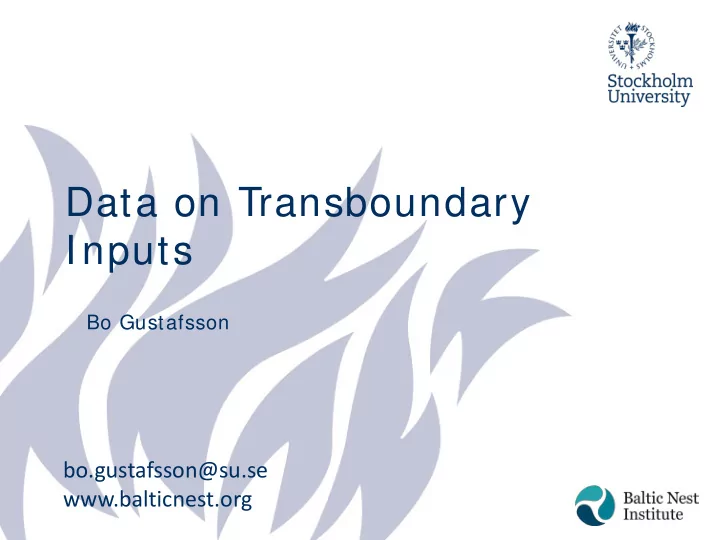

Data on Transboundary Inputs Bo Gustafsson bo.gustafsson@su.se www.balticnest.org
Pure border rivers ● Torne älv – Finland and Sweden ● Narva – Russia and Estonia These are split by constant fractions to each country: Torne älv Narva 1. Average is computed of Finnish 1. Estonian data is used and Swedish data 2. The inputs are split according to: 2. The average is split according to: • 67% Russia 55% Sweden • 33% Estonia • • 45% Finland
Torne Älv
Narva
Transboundary rivers ● Oder – Poland, Germany and Czeck Rep ● Vistula – Poland, Belarus and Ukraine ● Neva – Russia and Finland ● Pregolya – Russia and Poland ● Nemunas – Lithuania and Belarus ● Barta, Venta and Lielupe – Latvia and Lithuania ● Daugava – Latvia, Lithuania, Belarus and Russia Non-HELCOM country
Estim ates from PLC5 .5 representing 1 9 9 7 -2 0 0 3 :
For rivers w ith data reported 2 0 1 4 ( Oder* , Vistula, Pregolya, Daugava* * ) 1. Same retention as PLC5.5 is used 2. The share of each country contribution to the river input is calculated for both PLC5.5 and PLC6 (2014 or 2012), if available 3. The share is linearly interpolated to each year 1995-2014 4. Input contribution is computed by multiplying with total load each year 5. Flow normalization is performed assuming that runoff at the border is proportional to that at the mouth *German share was assumed constant **Lithuanian part treated separately
Values used River Country TN TP year Oder Czech Rep 3685 221 2012 Germany Vistula Belarus 300 2012 Ukraine Pregolya Poland 2665 180 2014 Neva Finland Including Daugava Russia 3111 115 2014 retention Including Belarus 4971 331 2014 retention Lithuania Lithuanian time-series Lielupe Lithuania Lithuanian time-series Barta Lithuania Lithuanian time-series Venta Lithuania Lithuanian time-series Nemunas Belarus Lithuanian time-series
Oder
Vistula
Pregolya
Neva
Daugava
Lithuania ● Lithuania has provided time-series of border loads for Barta, Venta, Lielupe and Daugava Rivers ● PLC5.5 retentions are used ● Flow normalization is performed on each time- series
One com plication: some years in the early part of the time-series the Lithuanian contribution is as large as the total river load! However, when summing up for sub-basins problems are not so evident.
Daugava
Com parison Lithuanian data and Latvian data in 2 0 1 4 Barta Venta Daugava Lielupe To BAP To GUR TN LV data 313 1522 582 6919 1835 7501 LT data 333 2079 1243 4398 2412 5640 TP LV data 8.5 16.5 8.7 59.3 25 68 LT data 4.9 22.7 22.4 47.9 28 70 • Largest differences in TN. • Less differences when summing up by sub-basin
Questions related to transboundary data ● Latvian data for Barta, Venta, Lielupe and Daugava – Are retention taken into account? ● Polish data for Oder and Vistula (and Pregoya) – what years are really in the table? – Are retention taken into account? – No data for TN Belarus and TN; TP Ukraine? ● Russian data for Pregolya – Are retention taken into account? ● Russian data for Neva – Are retention taken into account? – What retention should we use?
Recommend
More recommend